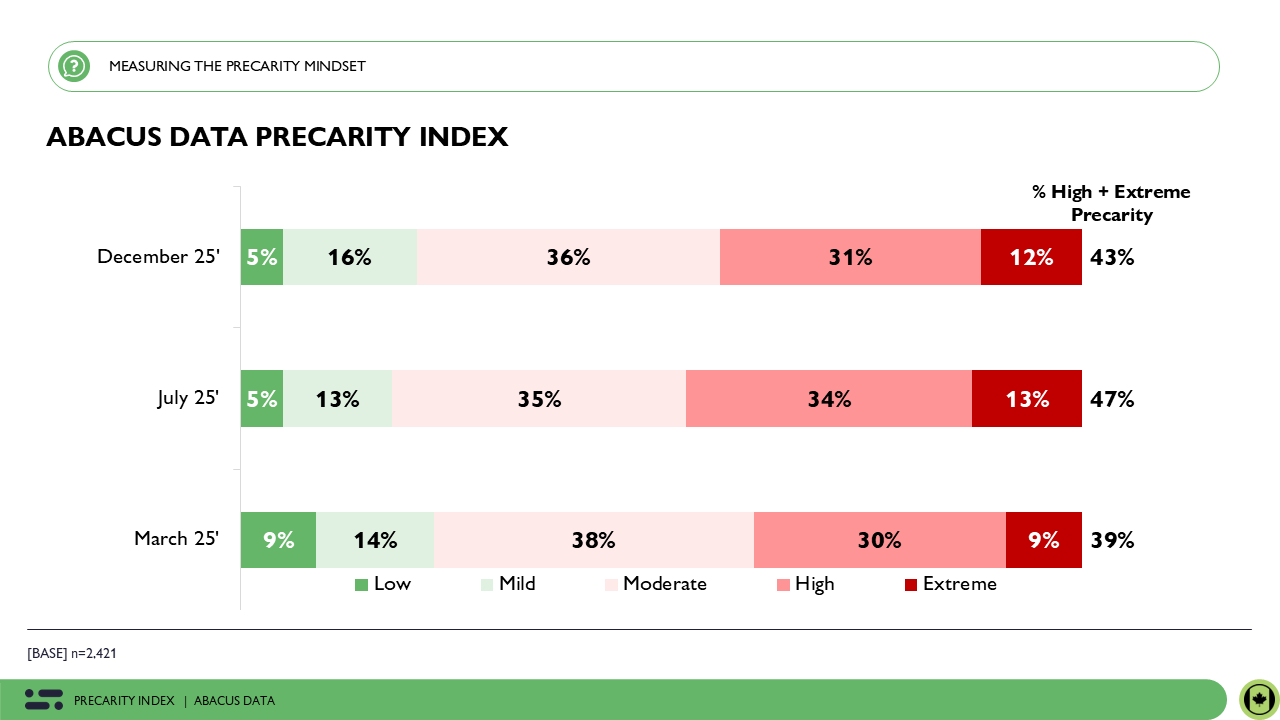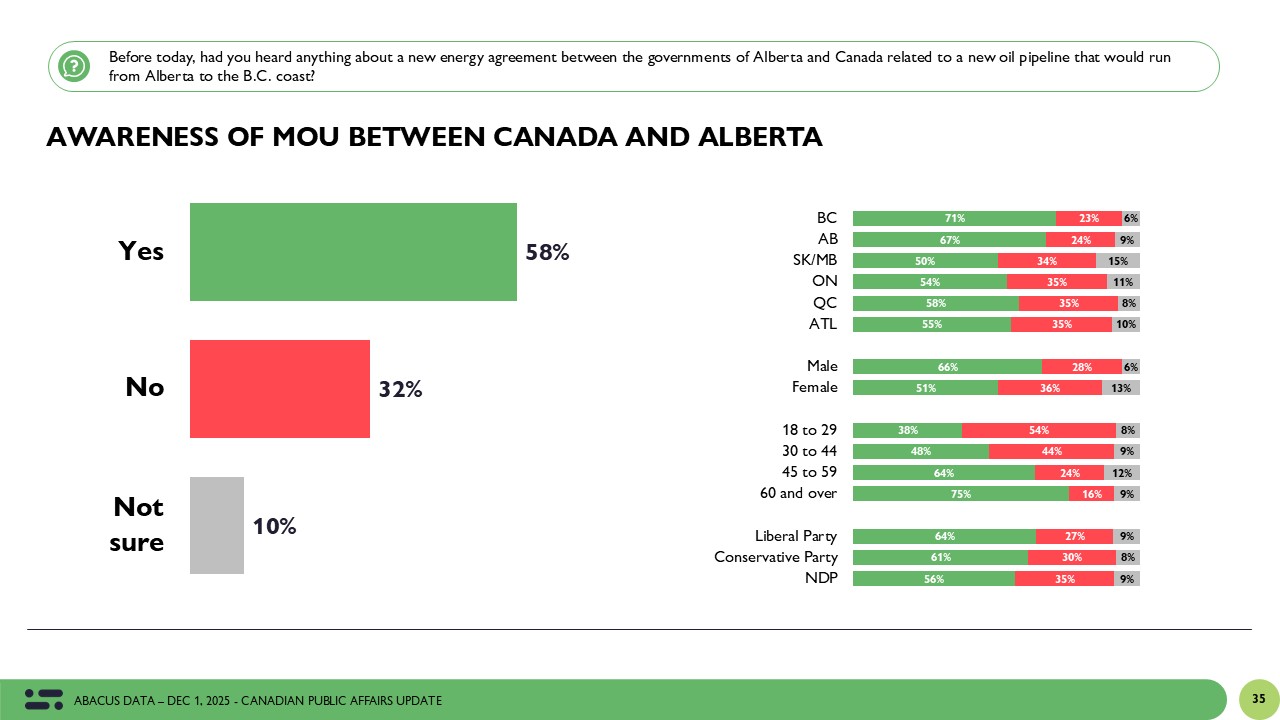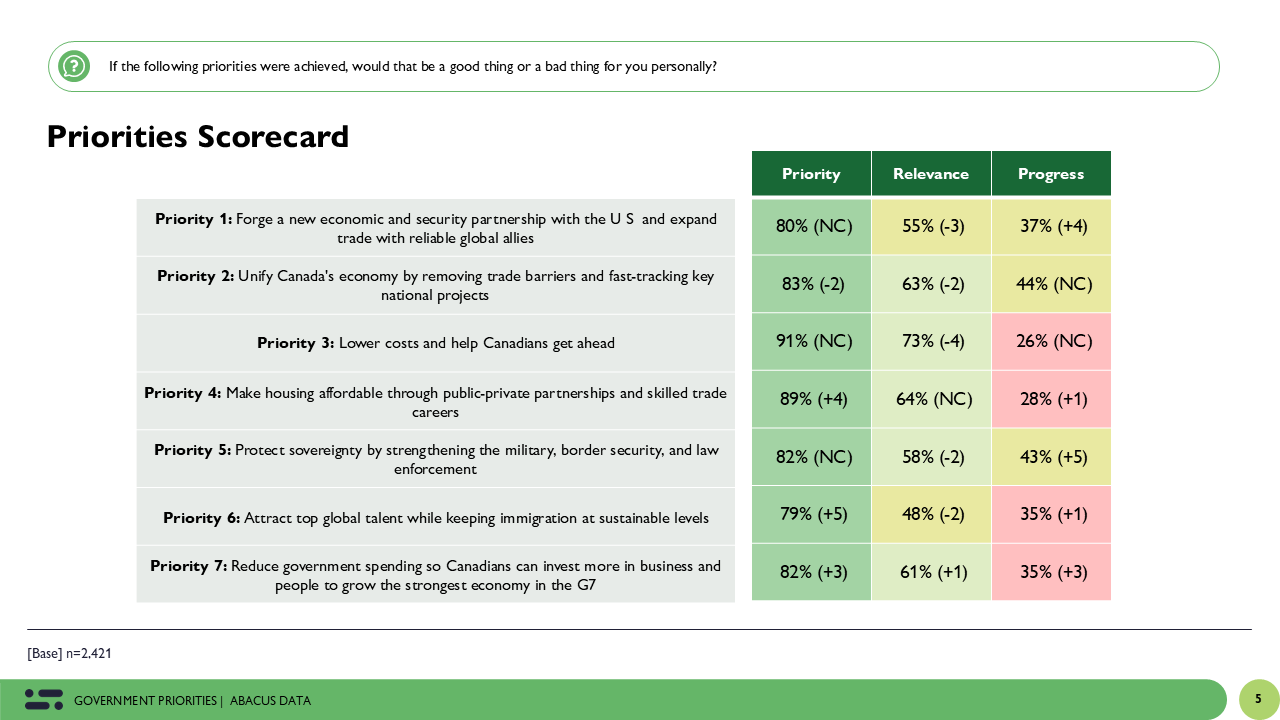Abacus Data Poll: Political Deadlock Persists as Carney Navigates Trump and Trade Pressure
October 19, 2025
Between October 9 and 15, 2025, Abacus Data surveyed 4,501 Canadian adults on the current state of federal politics. The findings show a landscape largely unchanged at the topline — a deadlocked race between the Liberals and Conservatives, steady impressions of Prime Minister Mark Carney, and consistent anxieties about cost of living and economic stability.
But this wave also captured a moment of high political visibility, as Carney’s trip to Washington and his high-stakes meeting with President Donald Trump dominated headlines. That moment — and Canadians’ reaction to it — offers new insight into how voters are evaluating Carney’s leadership on the world stage and the strategic space the Conservatives are working to exploit.
Trump, Trade, and Perceptions of Carney’s Performance + Would a Poilievre Government Do any Better?
The October tracking captured a rare high-visibility political moment: Prime Minister Mark Carney’s trip to Washington and his televised meeting with President Donald Trump. A full 74% of Canadians said they had seen or heard something about the visit, including 83% of those aged 60 and over, and 82% of past Liberal voters. In contrast, just 62% of younger Canadians (18–29) reported awareness, and even fewer had watched the Oval Office press conference.
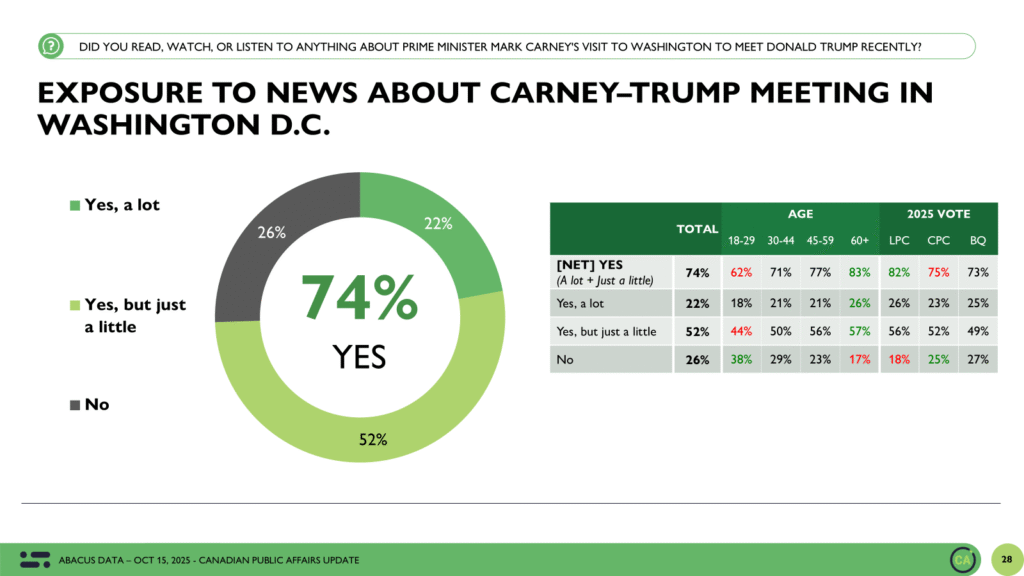
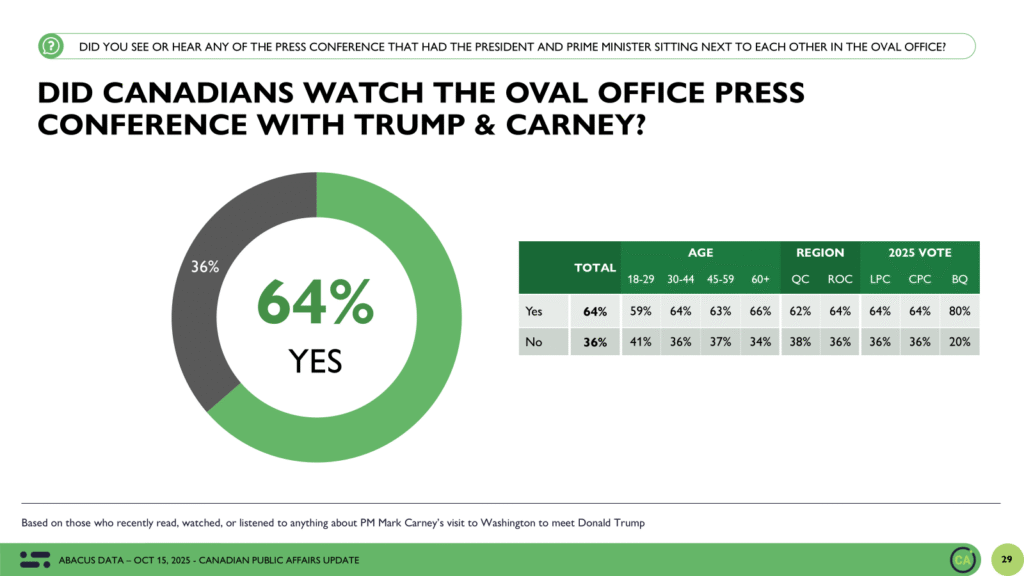
How Canadians learned about the Carney–Trump meeting underscores the generational divide not just in media consumption — but in political perception. While TV news remains the dominant channel overall (41%), it was the overwhelming source for older Canadians: 53% of those aged 60+ got their information this way, compared to just 30% among those under 45. Younger people, by contrast, were far more likely to rely on YouTube (31% of 18–29s), TikTok (13%), and X/Twitter (15%).
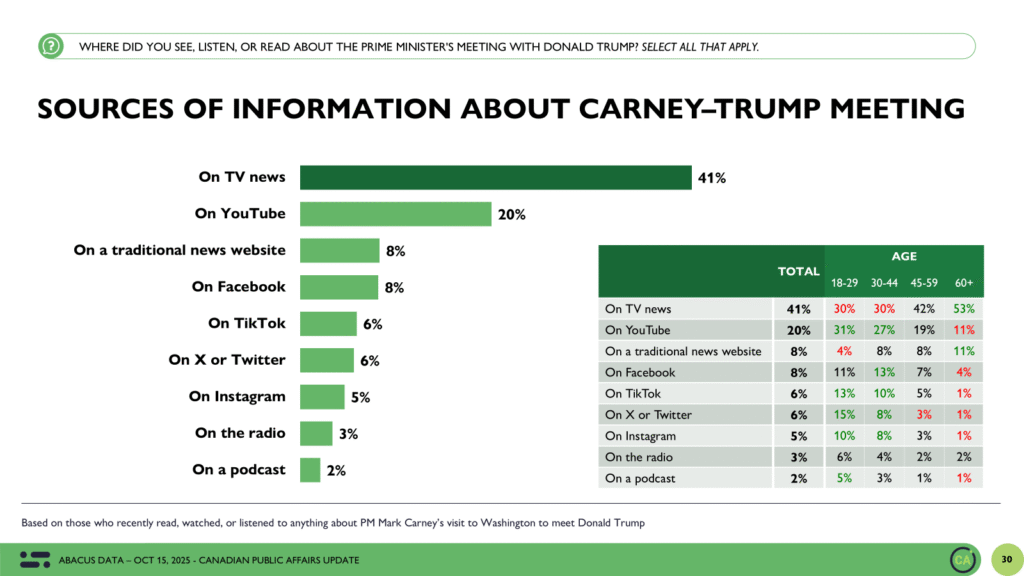
In other words, the same event was being filtered through very different media ecosystems. For older voters, the Oval Office meeting was delivered through the traditional lens of diplomacy, legacy institutions, and broadcast framing — all formats that tend to reinforce seriousness and stature. Younger Canadians, meanwhile, were more likely to encounter the moment in clipped, algorithm-driven formats, with lower trust thresholds and higher exposure to commentary or satire. That matters. Because while most Canadians saw the same images of Trump and Carney side-by-side, how they saw them — and what context surrounded them — likely shaped whether they came away reassured, confused, or disengaged.
This exposure gap matters, especially when it comes to shaping perceptions of leadership. Older Canadians were not only the most likely to see the meeting, they were also the most likely to approve of how Carney handled it: fully 74% in Atlantic Canada, 72% in Quebec, 65% in Ontario, and 92% of Liberal voters said he performed well. That performance rating was strongest among those already inclined to support the government, but even among softer segments like BQ voters or even Conservative voters, 63% and 39% gave Carney positive marks.
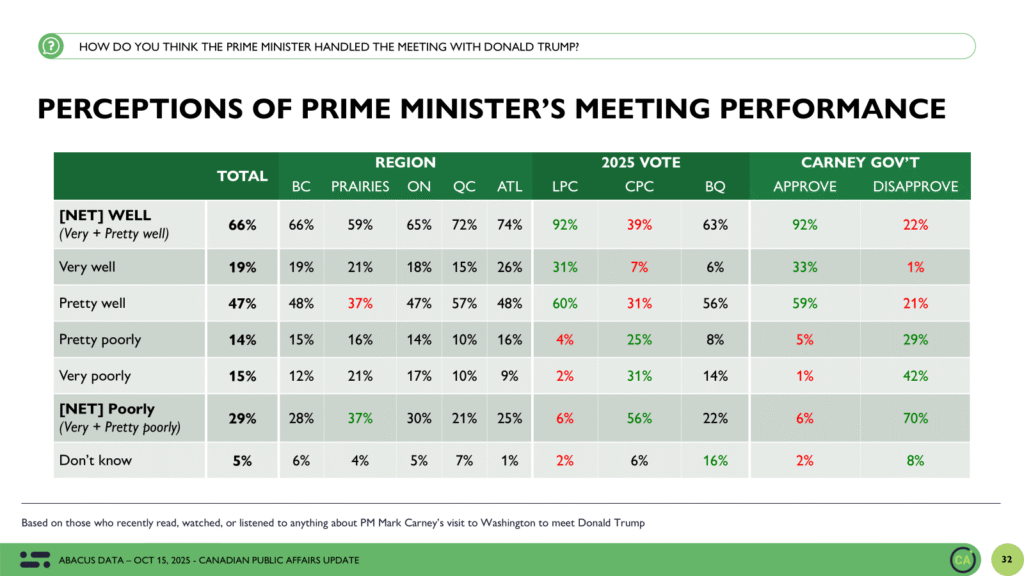
What’s more, we continue to see a pattern: when Trump is front and centre in the political conversation, the Liberal vote share among older voters grows. This wave is no exception. Among those aged 60+, the Liberals lead by 11 points over the Conservatives (47% to 36%) — their largest margin among any age cohort. The effect is amplified by the fact that older voters are also the most likely to get their information through conventional media — 53% watched TV news coverage, compared to just 30% of 18–29-year-olds, who consumed content more through YouTube, TikTok, or didn’t engage at all.
Still, this wasn’t a political slam dunk. While two-thirds said Carney handled the moment well (66% feel that way), the public is split on the government’s broader trade strategy. Just 39% believe the Carney government is striking the right balance with Trump, while the rest are divided between believing the approach is too soft (21%), unclear (21%), or too aggressive (6%).
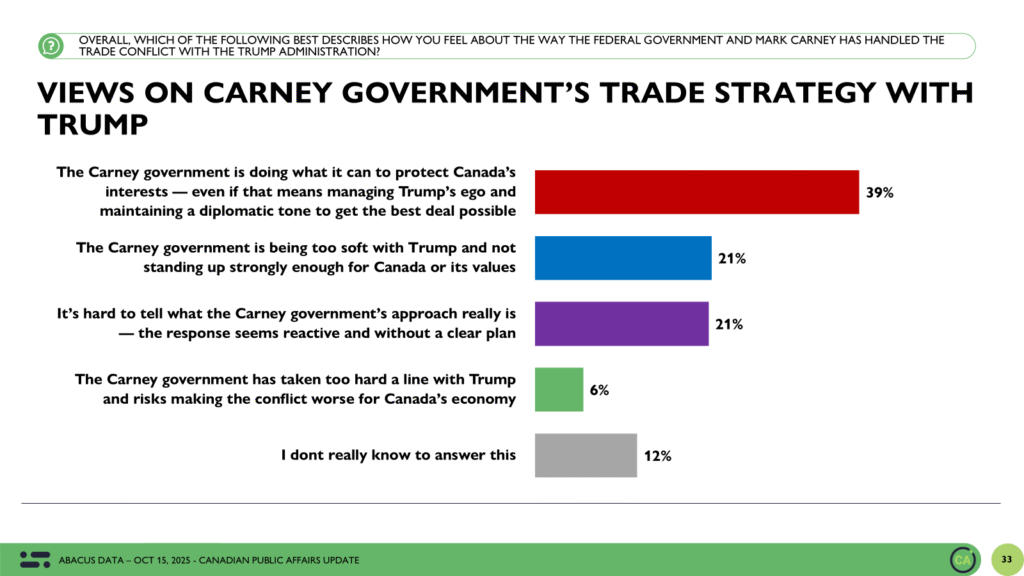
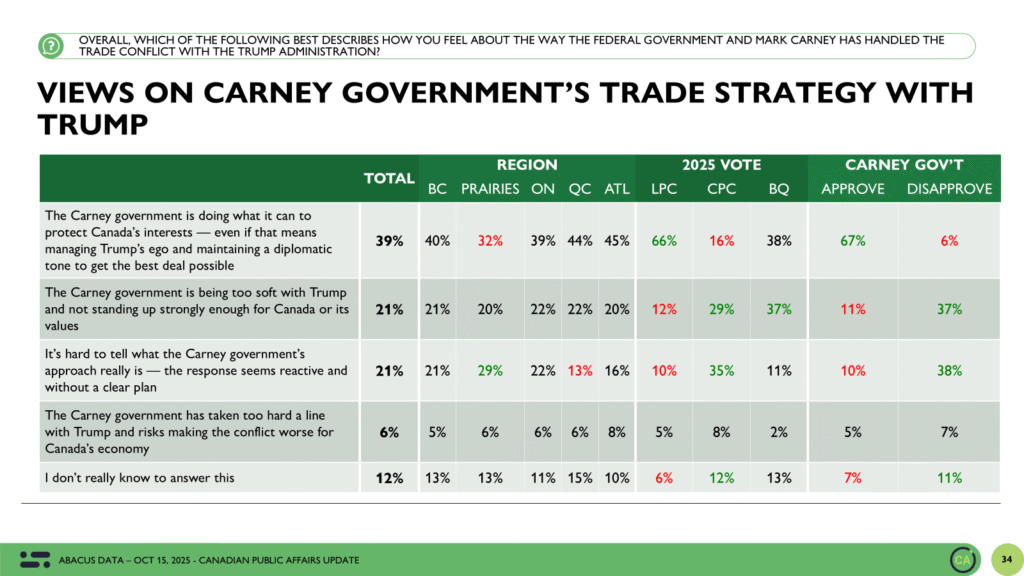
And expectations are low: only 14% think the negotiations will yield a fair and stable agreement, while most (52%) expect either real damage to the Canadian economy or a deal that still hurts key sectors. Importantly, most Canadians don’t see a clear alternative.
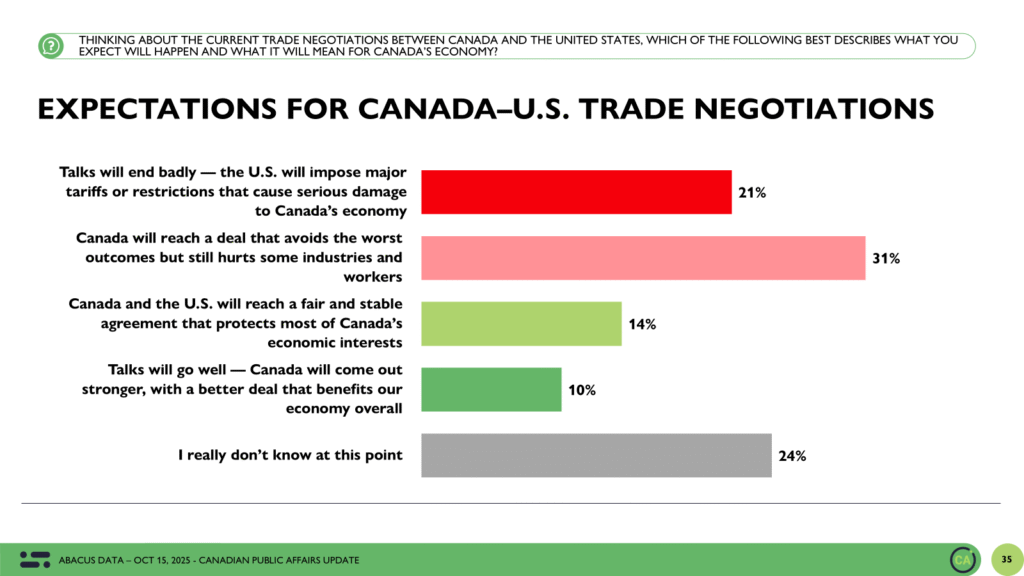
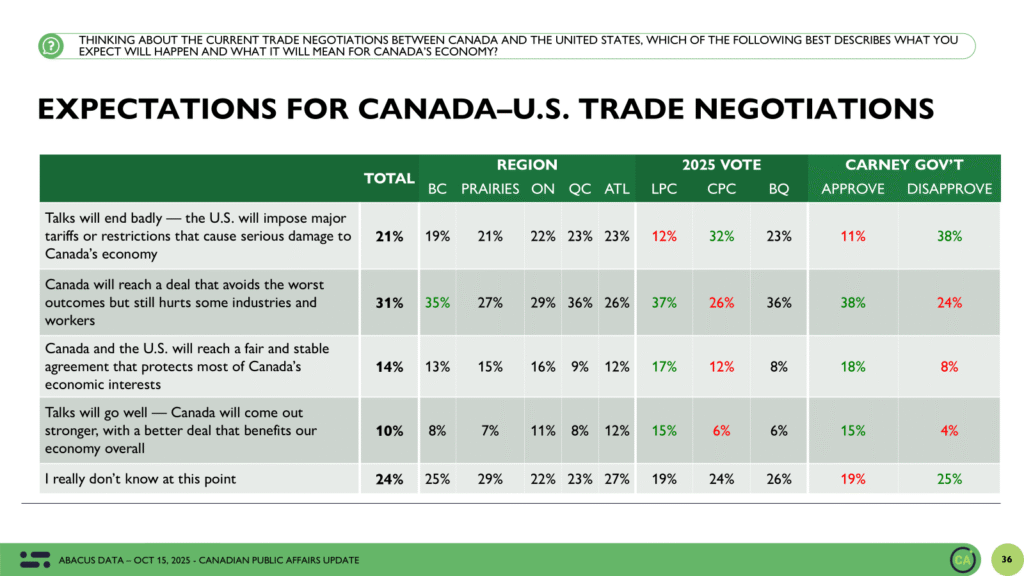
And yet, despite the heightened visibility and relatively strong marks for Carney’s performance, public opinion on the broader U.S. relationship remains cautious and doesn’t decisively favour either party. When asked whether things would be better under Pierre Poilievre and the Conservatives, just 29% agreed, while 32% said things would be worse, and a plurality of 40% said it wouldn’t make much difference because, in their words, “Trump is Trump.”
What’s striking is how little partisan consensus exists outside core bases: while a majority of Conservative voters (56%) believe Poilievre would improve Canada–U.S. relations, just 22% in Quebec and 29% in Ontario share that view. Conversely, more than half (54%) of Liberal voters believe Poilievre would make things worse, but that view is far from universal.
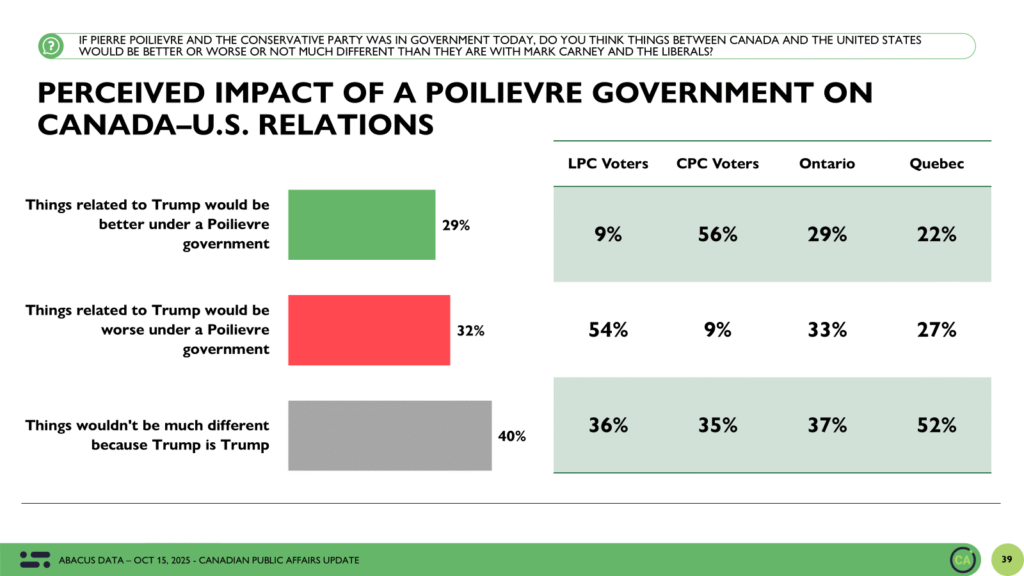
The fact that a plurality of Canadians default to the idea that “Trump is Trump” — that he shapes outcomes more than any Canadian leader could — reflects both realism and resignation. It also reveals a key communications risk for both parties: Canadians see Trump as unpredictable and dominant. That makes it harder for either Carney or Poilievre to frame themselves as having decisive influence. But in a climate where control is elusive, perception of competence matters, and in this case, voters appear more likely to reward steady stewardship over promises of tougher talk. For now, the Liberal strategy of managing rather than confronting Trump seems to be playing better with the broader public, particularly among older and more risk-averse voters.
The data points to a public that’s paying attention and not yet panicking. Most believe Carney held his own with Trump, and few are convinced Poilievre would do better. But there is an undercurrent of doubt about whether Canada is navigating these negotiations with enough clarity and resolve.
For the Carney government, the communications imperative is clear: project competence without appearing conciliatory. Reinforcing the notion that managing Trump’s unpredictability is a mark of leadership, not weakness, will be critical in the weeks ahead.
For the Conservatives, the challenge is harder. Despite efforts to frame Carney as weak or too diplomatic, most voters don’t believe they’d fare better under Poilievre. The “tougher with Trump” card might not play unless it’s backed by a more credible alternative vision and not just contrast.
Direction of the Country: Static but Not Improving
The public mood remains stalled. Only 34% say the country is headed in the right direction — unchanged from two weeks ago — while 48% believe we’re on the wrong track.
Global sentiment remains bleak: just 14% feel optimistic about the direction of the world, and only 13% feel that way about the U.S. under Trump.
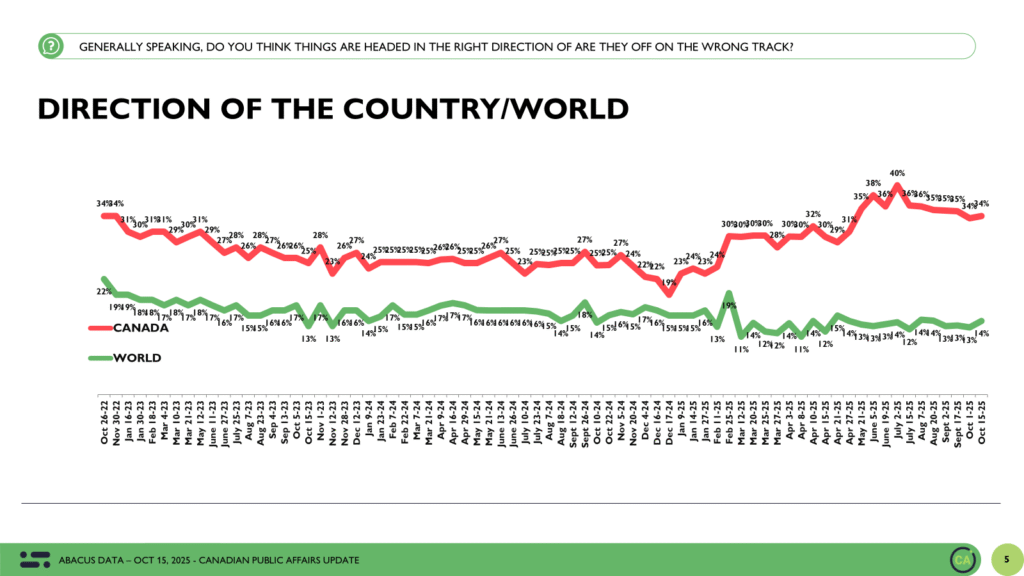
Top Issues: Affordability, Economy, and Trump Drive Concern
The rising cost of living remains the top concern for 62% of Canadians, unchanged from the last wave. The economy (38%, +3) and Donald Trump and his administration (35%, +2) round out the top three — reinforcing that both domestic affordability and international volatility are front-of-mind.
Other priorities like healthcare (35%), housing (34%), and immigration (29%) remain elevated, while crime has dipped slightly (17%, -4).
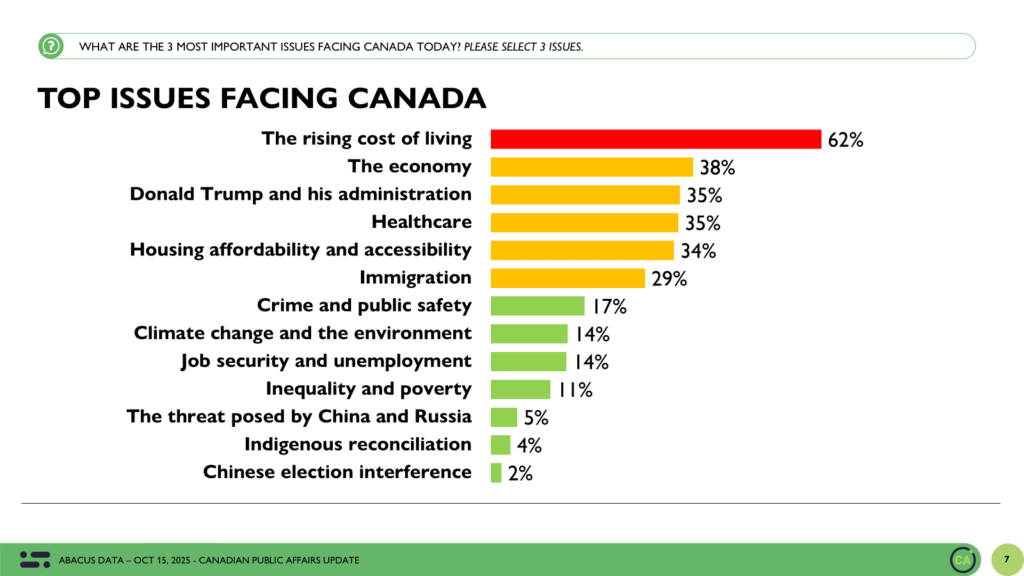
Government Approval: Stable and Generally Positive
Approval of the federal government led by Mark Carney sits at 48%, up two points from to two weeks ago. Disapproval is at 32%, unchanged from our previous survey.
The government’s approval remains 16 points above disapproval, a healthy gap for any government, especially one negotiating in a volatile international climate and navigating a very anxious public.
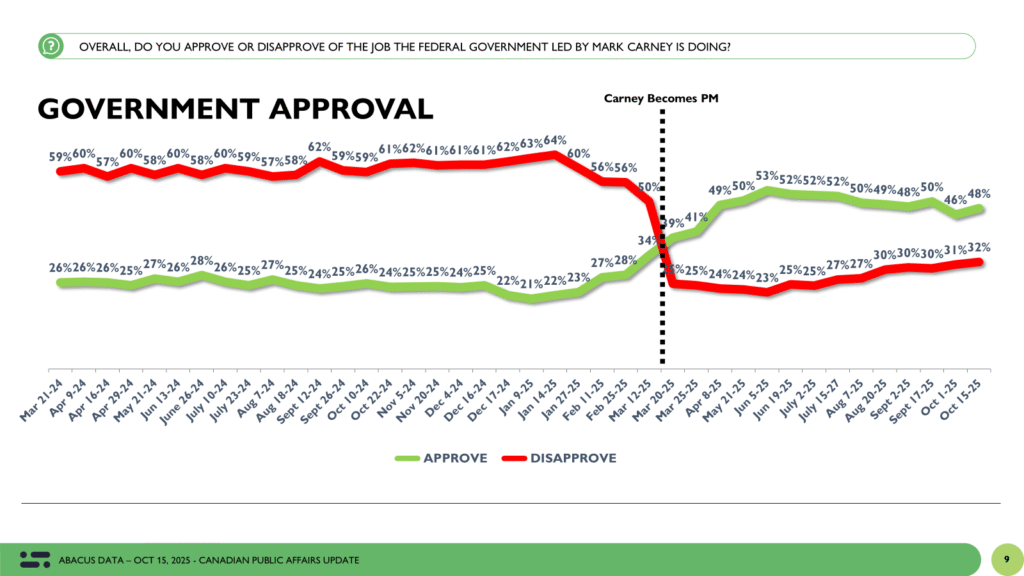
Leader Impressions: Carney Still Ahead
Mark Carney’s personal favourables remain solid and steady. 46% view him positively, while 31% hold a negative view, for a net favourability of +15 largely unchanged since August.
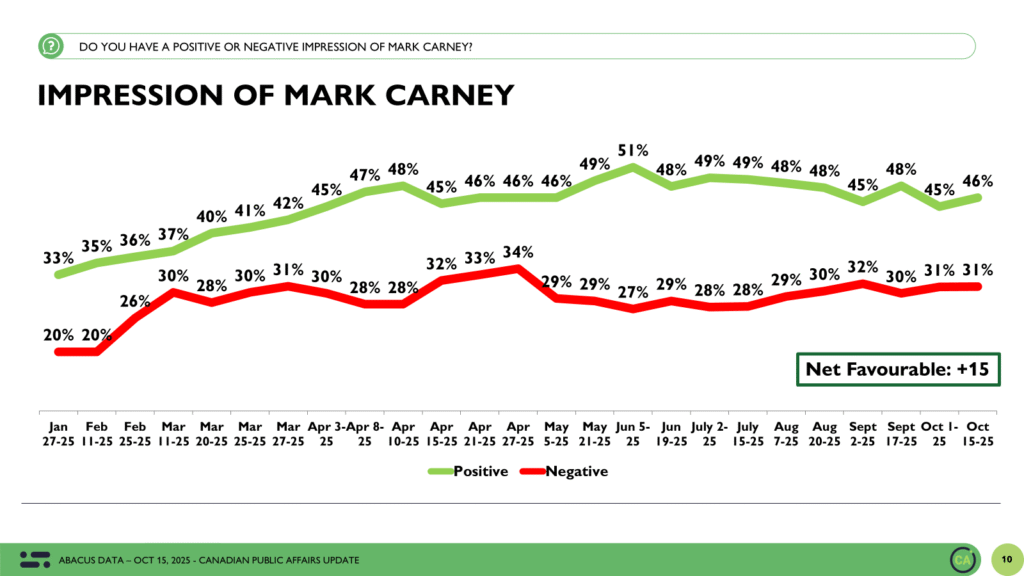
By contrast, Pierre Poilievre continues to lag, with a net favourability of -3 (39% positive, 42% negative).
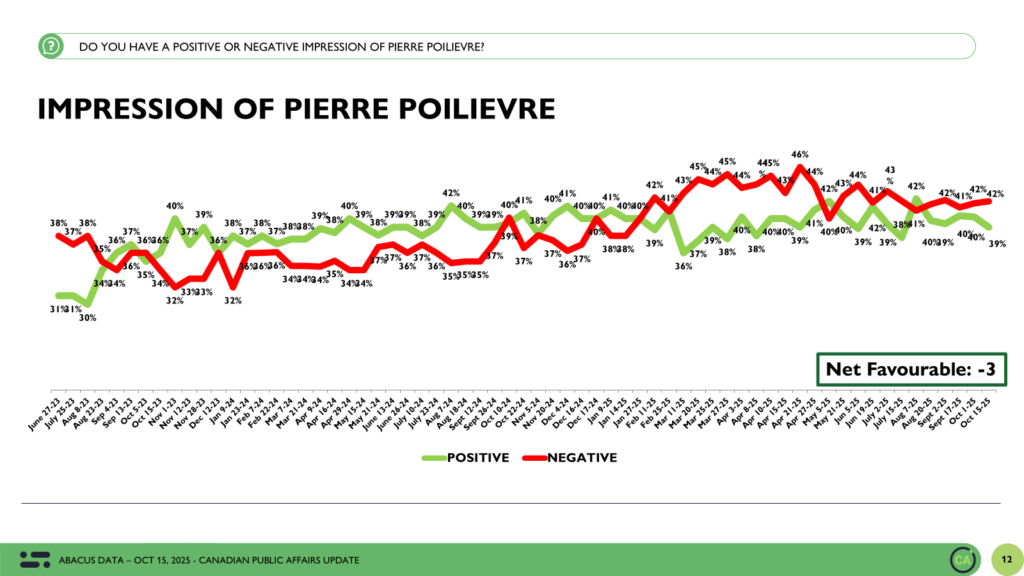
Vote Intention Unchanged from Last Wave
If an election were held today: Conservatives: 41% (NC), Liberals: 40% (NC), NDP: 8% (+1), Bloc: 7% (NC), Greens 3%
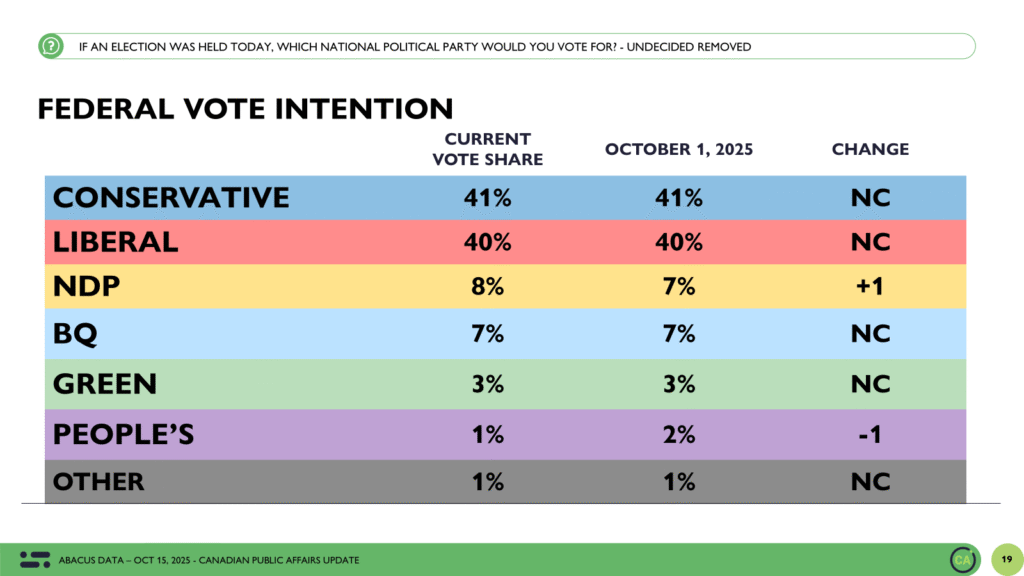
Among those certain to vote, the Conservatives have a 3-point edge (43% vs 40%) — a slight shift that could matter in a close election if turnout patterns hold.
Regional Spotlight (note we had large samples in British Columbia and Ontario)
Ontario: Liberals and Conservatives statistically tied (44% to 43%)
BC: Statistical tie with Conservatives at 42% and the Liberals at 40%.
Alberta: Conservatives dominate at 61% to 27% for the Liberals.
Manitoba: Conservatives at 42% vs. 39% for the Liberals
Saskatchewan: Conservatives 59% and the Liberals at 29%.
Atlantic Canada: Liberals lead 54% to 38% for the Conservatives.
Quebec: Liberals at 36%, BQ at 33%, Conservatives at 23%
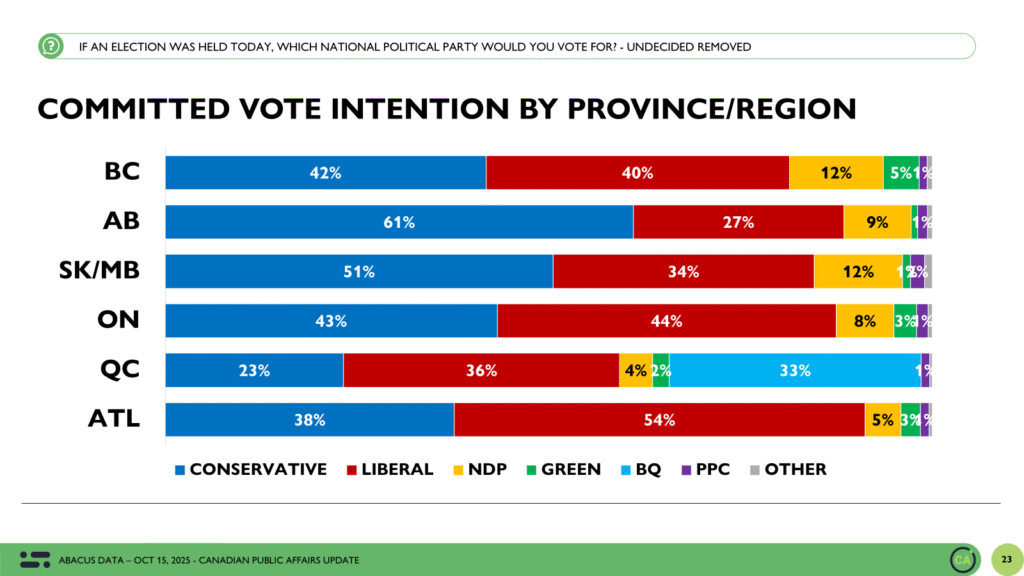
Interesting Generation and Life-Stage Dynamics
The generational divide in federal vote intention in this wave is striking(with a much larger sample size which improves confidence), with the most recent data highlighting a notable shift among older Canadians.
Among those aged 60 and over, the Liberals now lead by 11 points — 47% to the Conservatives’ 36%. This is a marked contrast from younger cohorts, where the choice is much tighter or even tilting Conservative. For example, among 45–59 year-olds, the Conservatives lead by 9 points (46% to 37%), and among 30–44 year-olds, the same – 9 points (44% to 35%).
But it’s that Boomer cohort where the Liberal advantage has re-emerged.
What’s important to note is that this widening lead among older voters consistently coincides with moments when Donald Trump dominates the news cycle. With Trump ranking as a top concern rising slightly again (the #1 issue for Boomers is Donald Trump (51%) vs healthcare at 44%), the Prime Minister’s brand continues to have a omparative edge among voters who are more risk-averse and fearful of the consequences of Trump’s leadership.
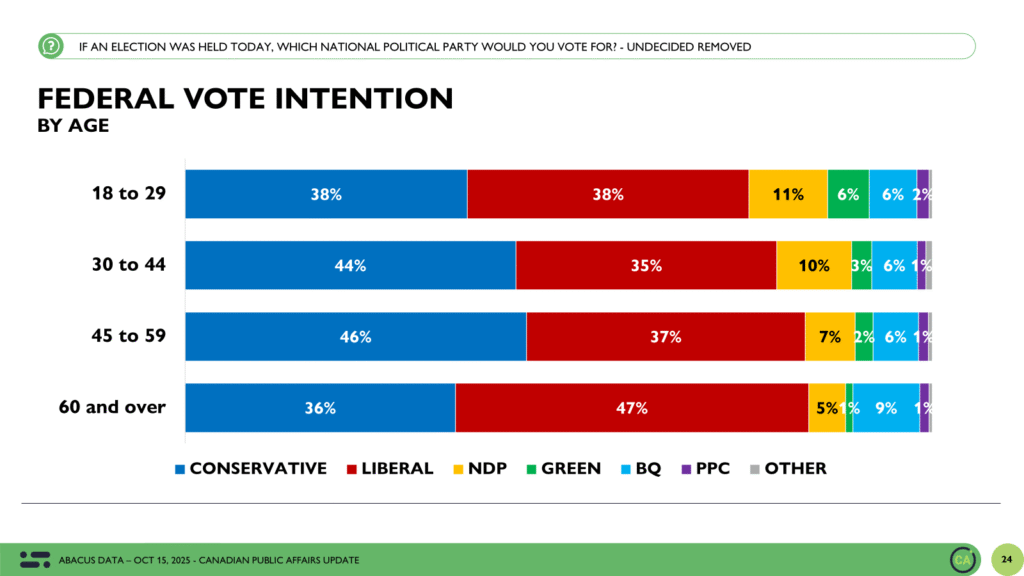
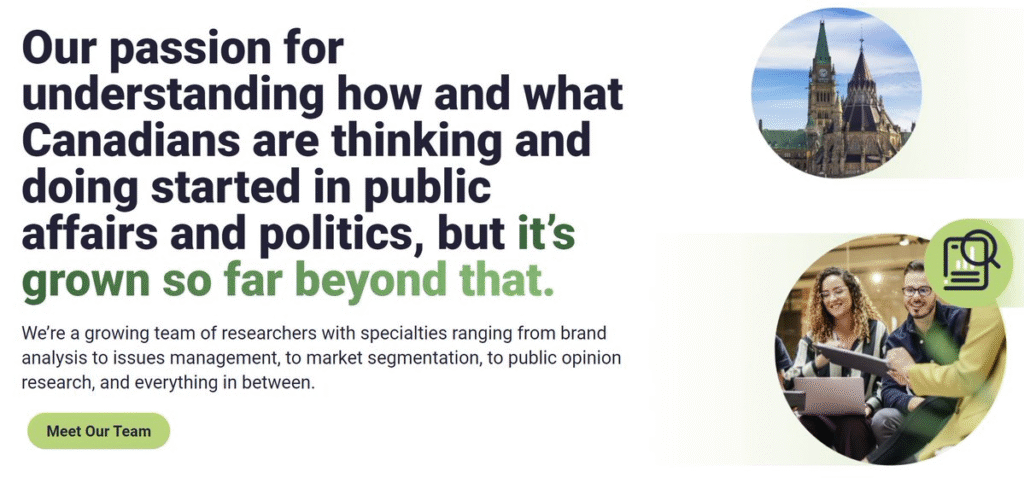
The Upshot
According to Abacus Data CEO David Coletto: “We continue to see a stable and tightly contested political environment. The Carney government’s numbers are holding — not breaking through, but not slipping either. And the Prime Minister’s handling of his meeting with Donald Trump appears to have reassured most voters, even if broader concerns about trade outcomes remain.
This wave reinforces a familiar story: a country on economic edge, but not in political flux. Most Canadians are tuned in, wary of Trump’s influence, and watching closely to see how the Carney government handles the storm.
For Carney, the opportunity lies in consistency. His brand remains stronger than his party’s, and his handling of high-profile moments — like the Trump visit — can help build the contrast needed to differentiate himself from both Trudeau’s legacy and the Conservative alternative.
The Conservatives continue to lead on cost-of-living concerns, but haven’t yet convinced voters that they’d offer a stronger hand in dealing with Trump or global uncertainty. And in an environment this tight, that absence of reassurance might be just as impactful as the presence of discontent.
With high visibility moments continuing and economic risks looming, stability may be Carney’s best asset, but the pressure to show strength is mounting.”

Methodology
The survey was conducted with 4,501 Canadians from October 9 to 15, 2025. A random sample of panelists were invited to complete the survey from a set of partner panels based on the Lucid exchange platform. These partners are typically double opt-in survey panels, blended to manage out potential skews in the data from a single source.
The margin of error for a comparable probability-based random sample of the same size is +/- 1.5%, 19 times out of 20.
The data were weighted according to census data to ensure that the sample matched Canada’s population according to age, gender, and region. Totals may not add up to 100 due to rounding.
Abacus Data follows the CRIC Public Opinion Research Standards and Disclosure Requirements that can be found here: https://canadianresearchinsightscouncil.ca/standards/
The survey was paid for by Abacus Data Inc.
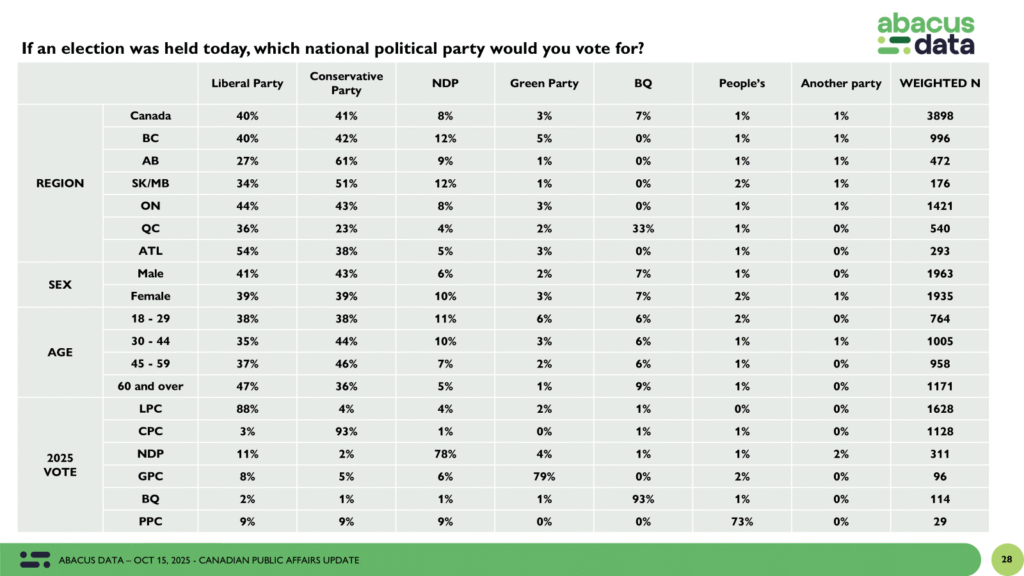
ABOUT ABACUS DATA
We are Canada’s most sought-after, influential, and impactful polling and market research firm. We are hired by many of North America’s most respected and influential brands and organizations.
We use the latest technology, sound science, and deep experience to generate top-flight research-based advice to our clients. We offer global research capacity with a strong focus on customer service, attention to detail, and exceptional value.
And we are growing throughout all parts of Canada and the United States and have capacity for new clients who want high quality research insights with enlightened hospitality.
Our record speaks for itself: we were one of the most accurate pollsters conducting research during the 2025 Canadian election following up on our outstanding record in the 2021, 2019, 2015, and 2011 federal elections.
Contact us with any questions.
Find out more about how we can help your organization by downloading our corporate profile and service offering.


